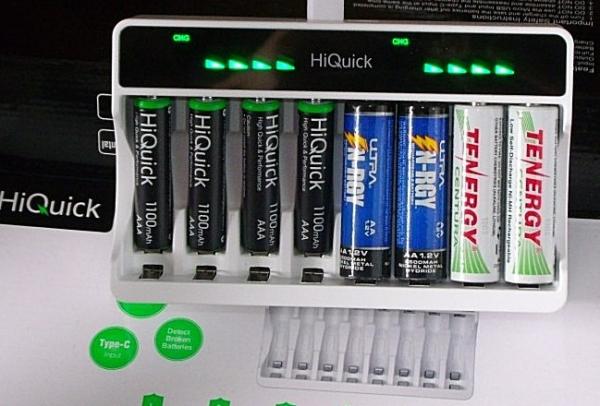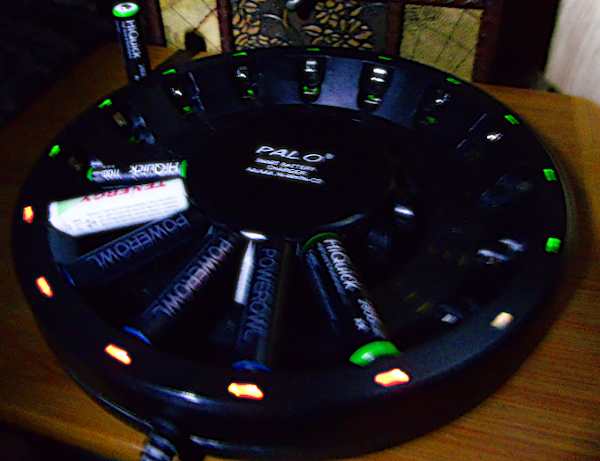Over the past couple of weeks, I’ve been learning more about rechargeable batteries and some of the technology behind them. I’ve also learned about the chargers that support them and some of the differences between them. In this post, I review two of the more modern chargers I’ve been using the last little while.
These chargers are for NiMH rechargeable batteries. I know lithium are today’s preferred batteries, with their greater power capacity. But, you know, I’ve never really trusted them. With so much power packed in those tiny cells, I think it’s just asking for trouble, especially those lithium polymer (LiPo) batteries. When they fail, they can cause an awful lot of damage. Unfortunately, I have to tolerate lithium batteries in my cell phone and in my laptop computer. But, as for my other electronics, I’m sticking with NiMH when ever I can. I’ve been using them for years and haven’t had any problems. They’re also relatively cheap and I feel I get good value for money with them.
As mentioned in my other post about rechargeable batteries, my latest battery charger was the HiQuick 8-bay USB “smart” charger. It, along with the HiQuick 2,800 mAh AA and 1,100 mAh AAA batteries, has been performing well. But, as I said above, I’ve been learning a few things about these new “smart” chargers that has got me thinking more about the best way to care for these types of batteries and how to get the best performance out of them.
What I’ve learned is that, chargers like the HiQuick charger are considered fast chargers. That means, they can push higher mAs out to the battery cells in order to charge them at a faster rate - that being a full charge in just a few hours, rather than “overnight”. In the case of the HiQuick, it will try to charge a battery at a maximum of 1,800 mAh (for AAs). They also (at least the better ones) have multiple ways of monitoring the cells as they charge, to keep them from over charging - but sometimes they fail and could drastically shorten the lifespan of the cells; or kill them altogether.
As I understand it, what happens is, as the NiMH cell approaches full capacity, there is a slight voltage drop for a moment. The charger monitors for this drop and, when detects it, switches to a trickle charge to bring the cell to full power and finish the charge. However, sometimes this voltage drop is too subtle to detect, so the charger just keeps on going.
A well built charger will have a backup way of going into trickle charge, if the voltage drop method fails, and that is a temperature sensor that cuts power when the cells get too hot. But, not all smart/fast chargers have this backup. So far, thankfully, I haven’t experienced any defective charges from the HiQuick charger. However, I do notice that near the end of the charge cycle, the batteries do get pretty hot. Although the manufacturer does say that the 2,800 mAh cells can take it, it leads me to wonder if there isn’t some operation life being sacrificed for the faster charge. In any case, with the kind of heat these batteries can get to, I can see the potential for a dangerous situation if things go wrong. It’s certainly less dangerous than lithium batteries, but still a hazard of some level.
During my research I’ve also learned an extra important tid-bit about these smart/fast chargers. If the charger is coming close to the end of the charge cycle (that is, if the batteries are feeling hot) and you happen to accidentally remove a battery from the charger, or the power goes out, do NOT put the battery back into the charger. When the batteries are in this end-phase of the charge and you stop and restart their charging, the charger may indeed miss the power drop it’s looking for. It’s better to just use the batteries as is and charge them after they’re depleted.
With the knowledge I had now gained, I went looking to see if there was a balance between smart/fast chargers and dumb/overnight chargers (like my Lenmar EGG-01). There actually is a go-between, a smart/slow charger, like this one I recently bought: the Palo 16-bay Smart Charger (PL-NC45).
What makes this smart charger a little different, apart from it’s UFO shape and that it can charge 16 batteries at once, is that it has a four stage charging cycle (pre-charge, quick charge, floating charge, then trickle charge). It also only delivers a maximum of 300 mAs to each cell, which drastically limits the heat generated by the charging. This, I think, is going to add extra charge cycles in the end to batteries I’ve invested in. The reduced power does make the charging process longer (going from 2 to 4 hours to 7 to 12), but I can live with that. This reduced power also means that the charger draws less from my home’s solar battery bank at one time. So, theoretically, on a cloudy day, my solar panels have more time to recover the power that has been taken by the charger. Okay, even 1,800 mAs for a couple of hours isn’t something that really taxes the battery bank, but still, every milliamp counts.
After using this charger several times now, I can say that the heat generated during charging is a fraction of what is generated by the HiQuick charger. The cells barely get warmer than room temperature. If anything, the center housing of the charger feels warmer than any of the batteries. As expected, each of the cells appear to be monitored separately from one another, as the the LED indicator for each turns green (meaning fully charged and in trickle mode) at different times. To be honest, I haven’t been able to pin down the particulars on how the charger detects the different charge phases. However, being a slower charge, the dangers of missing that critical voltage drop the fast chargers rely on, doesn’t appear to be an issue.
Side note: an interesting thing I’ve read about NiMH chargers is that generally, all of them continue to trickle charge while the battery cell is plugged in. This is why they all recommend removing the batteries after charging is complete. Leaving your batteries in for days can lead to problems, some chargers being worse than others.
Another advantage I’ve discovered from using this smart/slow charger over the smart/fast is that I’ve been able to charge some of my older NiMH cells that the HiQuick has rejected. There’s a very technical answer for the reason for this, but I won’t go into it here. Let’s just say, the lower mAs make a big difference in this situation. The unfortunate thing is, I didn’t know about this until after I threw away some of these older cells and I probably didn’t have to.
Overall, this Palo charger is probably going to be my go-to charger, unless I have a real need to charge a set of batteries faster. What I’m really hoping for is that, this lower powered charger is going to make my stock of NiMH batteries last even longer than their estimated 1,200 charging cycles.
I also decided to give these Powerowl NiMH batteries a try, too. They are rated with the same specifications as the HiQuick brand, but only half the cost. We’ll see how they compare. The HiQuick brand have been performing very well this past year and a half.
[tag]batteries, review[/tag]


